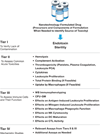Pre-clinical immunotoxicity studies of nanotechnology-formulated drugs: Challenges, considerations and strategy
- PMID: 26348388
- PMCID: PMC4688153
- DOI: 10.1016/j.jconrel.2015.08.056
Pre-clinical immunotoxicity studies of nanotechnology-formulated drugs: Challenges, considerations and strategy
Abstract
Assorted challenges in physicochemical characterization, sterilization, depyrogenation, and in the assessment of pharmacology, safety, and efficacy profiles accompany pre-clinical development of nanotechnology-formulated drugs. Some of these challenges are not unique to nanotechnology and are common in the development of other pharmaceutical products. However, nanoparticle-formulated drugs are biochemically sophisticated, which causes their translation into the clinic to be particularly complex. An understanding of both the immune compatibility of nanoformulations and their effects on hematological parameters is now recognized as an important step in the (pre)clinical development of nanomedicines. An evaluation of nanoparticle immunotoxicity is usually performed as a part of a traditional toxicological assessment; however, it often requires additional in vitro and in vivo specialized immuno- and hematotoxicity tests. Herein, I review literature examples and share the experience with the NCI Nanotechnology Characterization Laboratory assay cascade used in the early (discovery-level) phase of pre-clinical development to summarize common challenges in the immunotoxicological assessment of nanomaterials, highlight considerations and discuss solutions to overcome problems that commonly slow or halt the translation of nanoparticle-formulated drugs toward clinical trials. Special attention will be paid to the grand-challenge related to detection, quantification and removal of endotoxin from nanoformulations, and practical considerations related to this challenge.
Keywords: Anaphylaxis; Coagulopathy; Complement activation; Cytokines; Endotoxin; Hemolysis; Immunotoxicity; Nanoparticles; Phagocytosis; Pre-clinical; Protein binding; Thrombosis.
Copyright © 2015 Elsevier B.V. All rights reserved.
Figures






References
-
- Medzhitov R. Origin and physiological roles of inflammation. Nature. 2008;454:428–435. - PubMed
-
- Luebke R. Immunotoxicant screening and prioritization in the twenty-first century. Toxicol Pathol. 2012;40:294–299. - PubMed
-
- Smith DA, Schmid EF. Drug withdrawals and the lessons within. Curr Opin Drug Discov Devel. 2006;9:38–46. - PubMed
Publication types
MeSH terms
Grants and funding
LinkOut - more resources
Full Text Sources
Other Literature Sources
Medical

